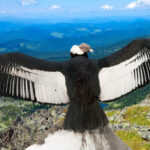Peacocks, with their stunning plumage and regal presence, are captivating birds to keep. However, a common question among owners, particularly in more open or semi-rural settings, is: “Do peacocks fly?” The answer is yes, peacocks can indeed fly, although perhaps not in the way you might expect from smaller birds known for their aerial agility. Understanding the nuances of peacock flight is key to ensuring their safety and keeping them happily within your property.
Peafowl are not built for sustained, long-distance flight like migratory birds. Their large size and elaborate tail feathers, especially in males, are not aerodynamic advantages. Instead, peacocks are capable of short bursts of powerful flight. They primarily fly to escape predators, reach higher vantage points for roosting, or navigate their territory. In a domestic setting, this might translate to flying onto rooftops, over fences, or into neighboring yards, as described by one concerned peacock owner.
The original poster’s situation is a common one: peacocks ranging freely during the day but occasionally venturing beyond property lines, causing concern with neighbors. The question then becomes, how can you manage peacock flight to keep them safe and be a good neighbor? Clipping flight feathers is often suggested as a solution. This involves trimming the primary flight feathers on one wing, disrupting the bird’s balance and making flight less effective. It’s crucial to clarify that this is clipping, not pinioning, which is a permanent and more invasive procedure. Clipping is generally considered safe and painless when done correctly, similar to trimming fingernails. It is a temporary measure, as feathers will regrow with each molt, usually annually.
However, clipping alone may not be a foolproof solution, especially if your peacocks are determined or feel threatened. Adding physical barriers like netting to existing fences, as the original poster considered, is a wise complementary strategy. Extending fence height with netting can significantly deter peacocks from flying over. A total fence height of 9 feet, as mentioned, is a substantial barrier.
To effectively keep peacocks at home, a multi-pronged approach is often best:
- Consider flight feather clipping: If your peacocks are prone to wandering, clipping flight feathers on one wing can reduce their ability to fly effectively over fences. Learn the correct technique to avoid injury and stress to the bird.
- Enhance your fencing: Netting extensions can make your fences a more significant deterrent. Ensure the netting is securely attached and taut to prevent sagging or creating entanglement hazards.
- Create a secure and appealing environment: Peacocks are less likely to seek escape if they feel safe and have their needs met within their designated area. This includes providing adequate space, shelter from weather and predators, roosting structures, and enrichment to keep them stimulated.
- Open communication with neighbors: As the original poster wisely considered, direct and respectful communication with neighbors is invaluable. Explaining the measures you are taking to keep your peacocks contained and providing contact information can go a long way in fostering good neighborly relations and addressing concerns proactively.
Ultimately, responsible peacock ownership involves understanding their natural behaviors, including their ability to fly, and taking appropriate steps to ensure their safety and well-being while minimizing any potential issues with neighbors. Combining flight management techniques with a secure and enriching environment is the most effective approach to keeping your peacocks happily at home.
